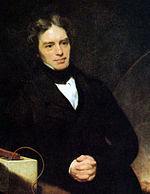Faraday's laws of electrolysis
Faraday's laws of electrolysis are quantitative relationships based on the electrochemical research published by Michael Faraday in 1833.[1][2] [3]
First law[]
Michael Faraday reported that the mass () of elements deposited at an electrode is directly proportional to the charge ( in ampere seconds or coulombs).[3]
Here, the constant of proportionality is called the electro-chemical equivalent (e.c.e) of the substance. Thus, the e.c.e. can be defined as the mass of the substance deposited/liberated per unit charge.
Second law[]
Faraday discovered that when the same amount of electric current is passed through different electrolytes/elements connected in series, the mass of the substance liberated/deposited at the electrodes in g is directly proportional to their chemical equivalent/equivalent weight ().[3] This turns out to be the molar mass () divided by the valence ()
- (From 1st Law)
Derivation[]
A monovalent ion requires 1 electron for discharge, a divalent ion requires 2 electrons for discharge and so on. Thus, if electrons flow, atoms are discharged.
So the mass discharged
Mathematical form[]
Faraday's laws can be summarized by
where is the molar mass of the substance (in grams per mol) and is the valency of the ions .
For Faraday's first law, , , and are constants, so that the larger the value of the larger m will be.
For Faraday's second law, , , and are constants, so that the larger the value of (equivalent weight) the larger m will be.
In the simple case of constant-current electrolysis, leading to
and then to
where:
- n is the amount of substance ("number of moles") liberated: n = m/M
- t is the total time the constant current was applied.
For the case of an alloy whose constituents have different valencies, we have
where wi represents the mass fraction of the i-th element.
In the more complicated case of a variable electric current, the total charge Q is the electric current I() integrated over time :
Here t is the total electrolysis time.[4]
This section needs expansion with: Real-life application/worked out eg. of Faraday's Laws. You can help by . (August 2020) |
See also[]
References[]
- ^ Faraday, Michael (1834). "On Electrical Decomposition". Philosophical Transactions of the Royal Society. 124: 77–122. doi:10.1098/rstl.1834.0008. S2CID 116224057.
- ^ Ehl, Rosemary Gene; Ihde, Aaron (1954). "Faraday's Electrochemical Laws and the Determination of Equivalent Weights". Journal of Chemical Education. 31 (May): 226–232. Bibcode:1954JChEd..31..226E. doi:10.1021/ed031p226.
- ^ a b c "Faraday's laws of electrolysis | chemistry". Encyclopedia Britannica. Retrieved 2020-09-01.
- ^ For a similar treatment, see Strong, F. C. (1961). "Faraday's Laws in One Equation". Journal of Chemical Education. 38 (2): 98. Bibcode:1961JChEd..38...98S. doi:10.1021/ed038p98.
Further reading[]
- Serway, Moses, and Moyer, Modern Physics, third edition (2005), principles of physics.
- Experiment with Faraday's laws
- Electrochemistry
- Electrolysis
- Electrochemical equations
- Scientific laws

























